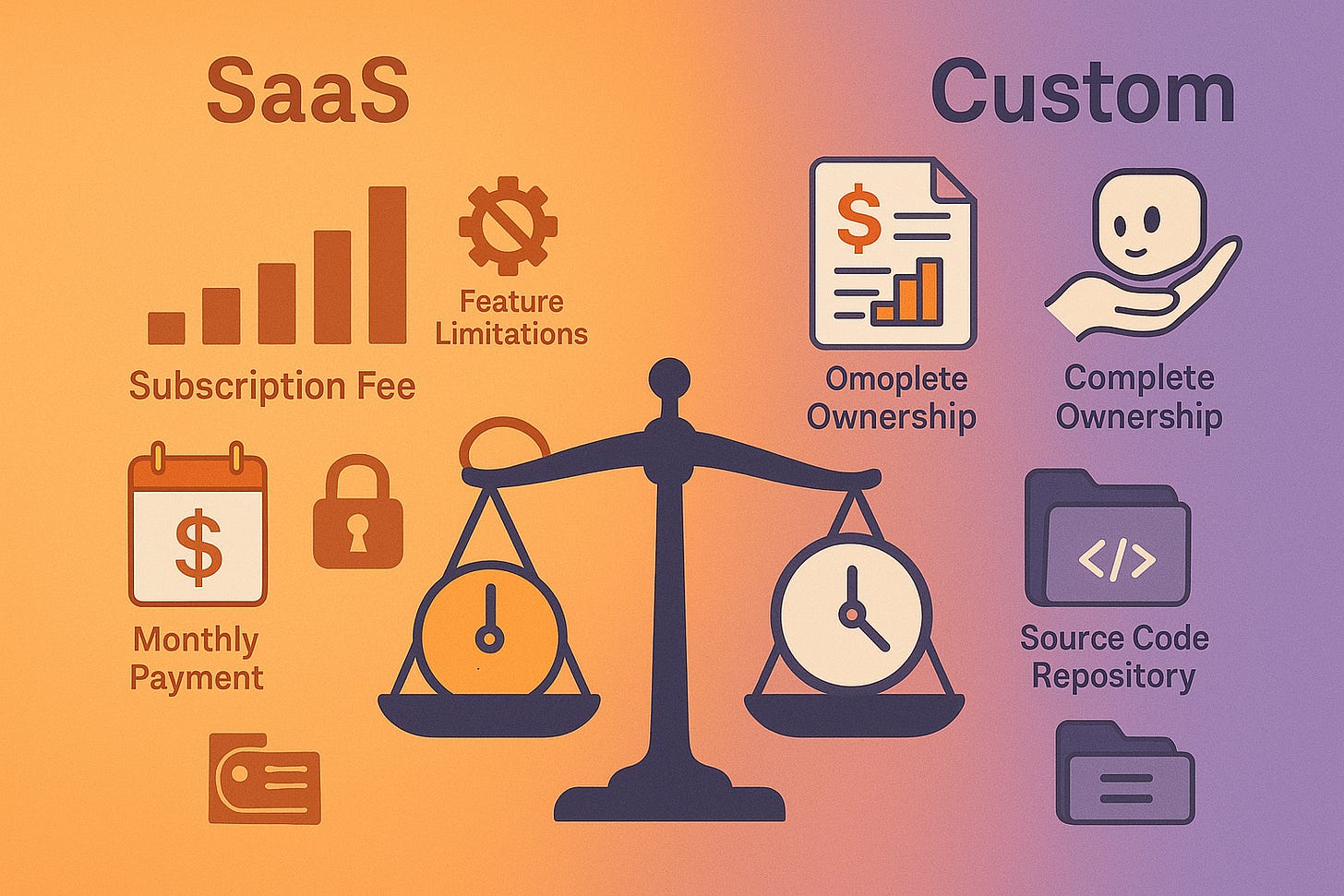Watch Out, SaaS Vendors! Custom Code Is Now Competitive
Jack Dorsey's "Apps In A Day" Heralding Something New?
The economics of software development just shifted dramatically, and many SaaS providers haven't noticed yet. When I can replicate 80% of a commercial DORA metrics platform in a week—functionality that once required months of development—we're looking at a fundamental market realignment.
Here's how it actually unfolded, and why it matters for anyone building or buying software.
The 2016 Version: Months of Engineering Investment
Back in 2016, the year Citymaps was acquired and I transitioned to Tripadvisor as Director of Engineering, I was working on a side project that consumed significant resources. We were building a SaaS service to track DORA metrics—developer productivity measurements that GitPrime dominated at the time.
The problem was clear: GitPrime was expensive and didn't track what actually mattered for engineering teams. Our approach was different. I focused on developing the metrics framework, my longtime Ukrainian engineering partner handled the implementation, and my business partner Joanie managed marketing and SEO.
The investment was substantial—tens of thousands of dollars in engineering time. We were product-ready and had our marketing plan locked down when the Tripadvisor opportunity presented itself. The chance to be a director at a public company was too compelling to pass up, so we shelved the project. Looking back, it was absolutely the right call—but that engineering investment represented months of focused development work.
At Tripadvisor, I implemented an organization-wide initiative to track DORA metrics, though I didn't get to see it through to completion. We ended up using Jellyfish, which one of our sister organizations had implemented successfully. Effective tool, but expensive and somewhat rigid in its approach.
The 2025 Version: One Week to Working Prototype
Jump to today. One of my clients is experiencing rapid engineering growth, struggling to develop effective developer feedback loops as they add internal resources and contractor support. I proposed building an automated data gathering and reporting tool to track specific metrics: Git commit statistics weighted for content, correlated with JIRA sprint metrics and goals.
This was essentially a significant portion of the work we'd done for our 2016 startup. Not multi-tenant, without dynamic report generation or extensive filtering options—but the core functionality was there.
Here's what I built over the course of a week, probably a few hours of actual engagement time - mostly checking data:
Daily data collection from GitHub and JIRA APIs
Data normalization and correlation with sprint expectations
Automatic project discovery in GitHub repositories
User profiles and aliases based on commit patterns
Anomaly detection and alerting system
Basic reporting dashboard
I expect to have an initial production system deployed within another week.
The Jack Dorsey Effect: Two Apps in One Week
Jack Dorsey's recent experiments perfectly illustrate this shift. In July 2025, the Twitter co-founder released two functional apps in a single week: BitChat, a Bluetooth mesh messaging platform, and Sun Day, a UV exposure and vitamin D tracking app. Both were built using "vibe coding" with Goose, Block's open-source AI coding assistant.
"It worked within a day," Dorsey wrote about BitChat. "So I added private messages, channels and private channels the next day."
This isn't just a tech celebrity showing off—it's a preview of how development economics are shifting for everyone. Dorsey described his approach as using "English and intelligence models" as the new programming language and compiler. While BitChat faced security scrutiny (highlighting the importance of proper architecture and security review), the speed of development represents something fundamental.
These weren't proof-of-concept demos. Sun Day integrates with Apple Health, calculates safe UV exposure based on skin tone and clothing, and tracks vitamin D intake. BitChat implements Bluetooth mesh networking with end-to-end encryption. Both apps reached functional beta status and user testing within days.
The broader implication: when a high-profile founder can build and ship two different categories of apps in one week, the barrier between "custom solution" and "just use SaaS" has essentially collapsed.
What Changed: The Agentic Coding Revolution
The difference isn't just in my experience level—though nine years of additional technical leadership certainly helps. The game-changer is agentic coding tools that handle the mechanical aspects of development while I focus on architecture and business logic.
Claude Multiagent PM handled the API integrations, data processing pipelines, and front-end dashboard components. I spent my time on the conceptual work: defining meaningful metrics, designing the correlation algorithms, and structuring the data relationships. The tool wrote the boilerplate, handled the OAuth flows, and even generated the SQL queries for complex data aggregations.
This represents a fundamental shift in development economics. Custom solutions that were previously prohibitively expensive are now cost-competitive with SaaS alternatives—especially for organizations with specific requirements that don't map perfectly to off-the-shelf products.
The SaaS Vulnerability
SaaS providers (and no/low-code tool providers, another SaaS category that once owned this space) built their business models on a simple premise: custom development is expensive, so businesses will pay monthly fees for generalized solutions. That equation is breaking down rapidly.
Consider the math. A mid-market DORA metrics platform might cost $10,000-$50,000 annually. My client's custom solution required approximately 40 hours of my time at consulting rates—a one-time investment that delivers exactly the functionality they need, integrates perfectly with their existing systems, and remains under their complete control.
The custom solution isn't just cost-competitive—it's strategically superior. They maintain complete control with no monthly fees and restrictive licensing, and they'll have well-organized and documented source code that they can give to AI to maintain. It's exactly the type of simple greenfield project that agentic coding excels at.
For SaaS vendors, this creates three immediate challenges:
Commoditization pressure: When custom development becomes affordable, generic solutions lose their value proposition unless they offer genuinely unique capabilities.
Feature bloat liability: The comprehensive feature sets that justified high SaaS prices become disadvantages when customers can build exactly what they need.
Integration complexity: SaaS products that require significant configuration or don't integrate seamlessly with existing workflows become less attractive than purpose-built alternatives.
What This Means for Different Stakeholders
For Engineering Leaders
Evaluate your current SaaS stack with fresh eyes. Which tools are you paying for primarily because custom development seemed too expensive? With agentic coding capabilities, that calculation may have changed dramatically.
Consider hybrid approaches: use SaaS for complex, specialized functionality while building custom solutions for workflows that map directly to your specific business processes.
For SaaS Vendors
The competitive landscape just intensified. Success now requires demonstrating clear value beyond what a competent developer with agentic tools can build in weeks.
Focus on genuinely difficult problems: machine learning capabilities, complex regulatory compliance, or sophisticated integrations that require deep domain expertise. Avoid competing on basic CRUD operations or simple workflow automation.
For Startups and Scale-ups
Custom development is no longer a luxury reserved for large enterprises. For many use cases, building exactly what you need is now more cost-effective than adapting your processes to fit generic SaaS solutions.
This particularly applies to internal tools, data processing pipelines, and workflow automation—areas where your specific requirements might not align well with market offerings.
The Broader Implications
This shift extends beyond individual tool decisions. We're seeing the emergence of boutique software—custom solutions built rapidly for specific use cases that would have been served by SaaS platforms just a few years ago.
The barrier to entry for competing with established SaaS providers has dropped dramatically. A skilled developer with modern agentic tools can now build competitive alternatives to many SaaS products in weeks rather than months.
This doesn't spell doom for all SaaS companies, but it does force a reckoning with value propositions built primarily on development cost arbitrage rather than genuine innovation.
Looking Ahead
My client's DORA metrics system will go live next week. It does exactly what they need, integrates seamlessly with their existing tools, and cost a fraction of what a comparable SaaS solution would require annually.
This isn't an isolated case—it's a preview of how development economics are shifting. Organizations that recognize this trend early will build significant competitive advantages through custom solutions that fit their exact needs.
SaaS vendors that adapt by focusing on genuinely complex problems will thrive. Those that continue competing on basic functionality will find themselves increasingly vulnerable to boutique alternatives built specifically for their customers' requirements.
The age of "good enough" SaaS solutions may be ending faster than anyone expected.
The tools that once made custom development prohibitively expensive have been replaced by AI-powered assistants that make it cost-competitive. The question isn't whether this trend will continue—it's how quickly organizations will recognize and act on the new opportunities it creates.
Related reading: For more insights on agentic coding tools and their impact on software development, visit HyperDev





